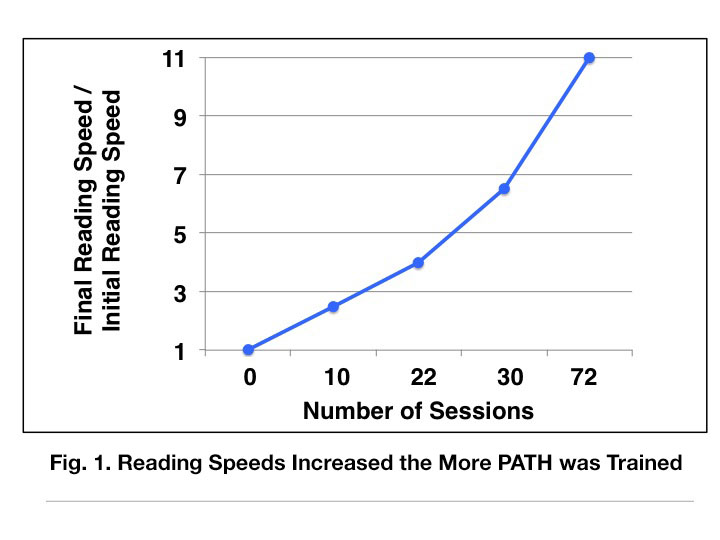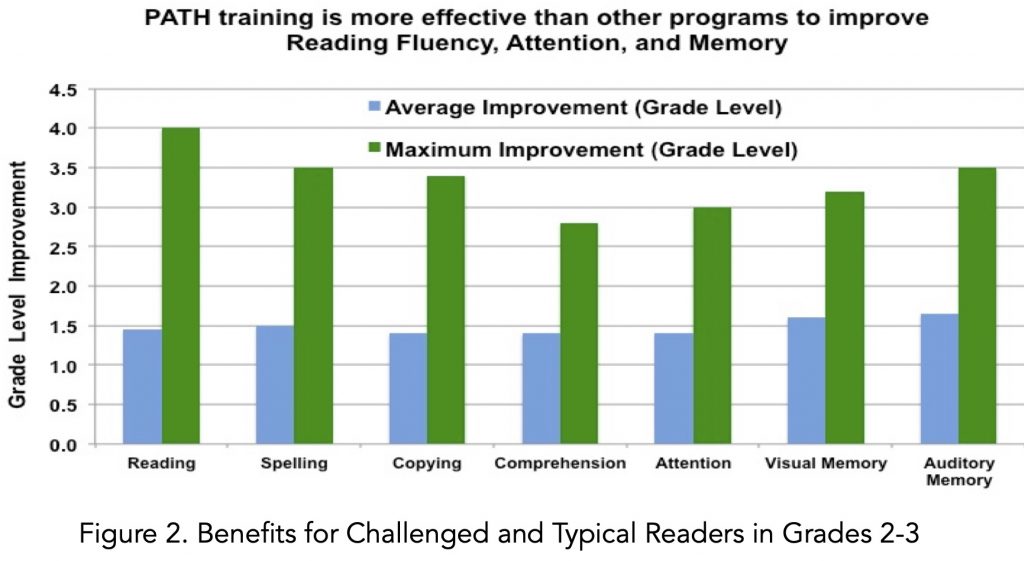Demos / Research
PATH to Reading/Insight is a simple computer program that students learn how to do by watching a 4-minute video, and their parents or teacher learn how to administer by watching an 11-minute video (see demos below).
Demonstration Videos
For Students – Path to Reading – Program Overview
For Students – to learn more about the PATH Reading Rate program
For Therapists – Learn How to Administer PATH Program
For Therapists – to learn more about the Reading Rate program
For Students – to learn more about the PATH Motion Memory program
Research
PATH has been proven through controlled validation studies as a breakthrough technology that significantly improves reading fluency, attention, and working memory through its direction discrimination therapy. PATH is even more effective when started at ages six to eight, which is when these brain pathways are developing. These studies have also shown that the more training on PATH, the more reading fluency, attention, and memory improve.
PATH (previously known as MovingToRead) was used in controlled clinical studies in four elementary schools in the Santa Monica-Malibu and Los Angeles Unified School Districts:
- 2002-2003, 107 students in 2nd grade and
- 2003-2004, 106 students in 2nd and 3rd grade.
During these studies, standardized tests of reading skills were administered to every student in the study, initially and at the end of the study, to measure their improvements in the perceptual and cognitive components used in reading.
PATH was also used in controlled clinical studies in the San Diego Unified School District. (click here to see the publication of this study). During these studies standardized tests of reading skills, attention, and both visual and auditory working were used to measure improvements following PATH training.
Results
The results of controlled validation studies found that all children who were trained on left-right movement discrimination (PATH) had large improvements in their sensitivity to direction discrimination. In all studies (click here for the publications, and click here for a review article of these studies), both challenged readers and typical readers improved significantly.
Challenged readers improved four-fold in seeing movement more easily for low contrast (dim) patterns, and typical readers improved three-fold following training in discriminating the direction of motion.
The more PATH was trained: 1) the more reading speeds improve, as shown in Figure 1 below, and 2) the more these improvements are sustained over time, resulting in significant benefits that last for a lifetime.
 Both challenged readers and typical readers who were trained on PATH increased over a grade level on reading skills: word identification, spelling, and reading comprehension, attention and both visual and auditory working memory, see Figure 2 below, some improving up to 4 grade levels, after only 48 sessions of training on PATH, 4 sessions each week for 12 weeks.
Both challenged readers and typical readers who were trained on PATH increased over a grade level on reading skills: word identification, spelling, and reading comprehension, attention and both visual and auditory working memory, see Figure 2 below, some improving up to 4 grade levels, after only 48 sessions of training on PATH, 4 sessions each week for 12 weeks.
PATH neurotraining, improving visual timing, was compared to FastForWord (FFW), improving auditory timing, and Learning Upgrade (LU), improving associating sounds with letters, in a controlled validation study in the San Diego Unified School District. Both FFW and LU were completed for 30 minutes 5 days a week, whereas PATH training was completed 3 days a week for 20 minutes, for a total of 20 weeks. The Table below shows that FFW improved attention, and both visual and auditory working memory 5% more than after LU, whereas PATH training improved attention, and both visual and auditory working memory 15% more than after LU.
Click here to download Lawton (2016) in Frontiers in Human Neuroscience where these results are published.
After 12 weeks, cognitive skills improved significantly more following PATH neurotraining for 20 minutes 3 times a week than following Raz-Kids guided reading for 30 minutes 3 times a week, see Table below. The data from this study (Lawton & Shelley-Tremblay, 2017) found that the improvements following PATH neurotraining, had a very large effect size (Cohen’s d). Effect sizes of 0.9, 1.2, 0.8, 1.0, 1.1, and 1.1 were found for reading speed, reading comprehension, pronunciation, attention, visual working memory, and auditory working memory, respectively, by examining the interaction term between Training and Time. These effect sizes are substantially larger than reported by other studies, being around 0.2 in studies designed to improve these cognitive skills.
To learn Why people with Reading and Attention problems Benefit from PATH neurotraining:
Click Here
To learn Why people with Concussions Benefit from PATH neurotraining: Click Here
To see Summary of How and Why PATH neurotraining is essential for improving brain function and ease of learning: Click Here
To see PowerPoint Presentation slides of the neuroscience behind why and how PATH neurotraining improves brain pathways so that reading challenged individuals rapidly become typical readers:
Click Here
View Publications to see details of these studies that were conducted over the past 20 years.
